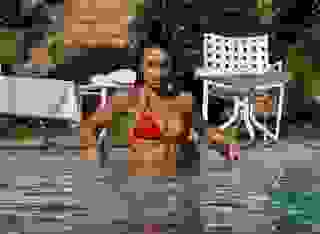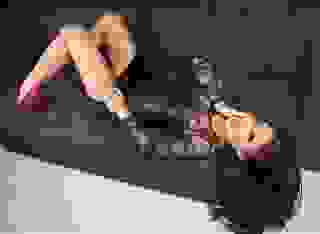Note: You can change font size, font face, and turn on dark mode by clicking the "A" icon tab in the Story Info Box.
You can temporarily switch back to a Classic Literotica® experience during our ongoing public Beta testing. Please consider leaving feedback on issues you experience or suggest improvements.
Click hereMy water comes from the small river that runs through the property. I have a pedal operated manual pump that brings water from that river to a plastic three hundred gallon tank inside the bunker. The first time I filled the tank, it took me almost an hour and a half of pumping, but with the little water I figured I'd use myself, it would take only about fifteen minutes a day. A screen at the inlet to the pipe filters out the minnows and big stuff. A filter and a little bleach added to the tank when I fill it takes care of any bacteria and other things that might be in the water.
That tank is plumbed to the kitchen sink and the bathroom sink. To use the shower, I have to heat water and then pump it into a tank above the shower with another pedal powered pump. The tank holds enough for about a five-minute shower. It's kind of a pain, but with this setup, I don't need a water heater. The drains from the sinks and shower flow by gravity out to a small depression a hundred feet from the bunker. The little pond soaks in almost as soon as it fills.
After it was done, I started furnishing it using some of the information I'd read and with some things I just thought were good things to have. I'd read that it is really hard to survive a disaster on your own, so it pays to plan on having a few people to help. That meant I'd have to have a place for them to stay.
I put a queen-size bed in the bedroom and a couch that folds out into a bed in the living area. I bought enough wool blankets to have four on each bed plus three changes of sheets. So I'd have a place to eat and work, I bought four chairs and a small table.
I didn't need a refrigerator, but I did need a wood-burning stove for heat and to cook on. I found an affordable one made of welded steel that even had a small oven. It needed a chimney, but when we'd poured the roof of the bunker, we'd installed a clay chimney that went up about three feet above ground level just for that purpose. Above ground level, we formed concrete around it so it looks like a big rock.
The bunker is ventilated by a small electric fan that pumps air into the bunker through a twelve inch PVC pipe and out through another that are hidden by some bushes, so I did need some electricity for that. I also needed lights in the bunker since I wasn't going to run electricity all the way from the road.
An array of solar panels and a battery bank like some recommended was not something I wanted. Solar panels have to be angled to catch as much sun as possible, and the reflection from them would be visible for miles under the right conditions. The other problem with solar power was if it was cloudy for very long, I'd be stumbling around in the dark.
I'd bought a hand-cranked radio so I'd have some contact with the outside world, and I was cranking up my radio one Saturday afternoon when I wondered if anyone sold a bigger hand-cranked generator. As it turned out, there were several options but they weren't cheap. I needed another method.
I'd designed similar electro-mechanical things over the years as part of my job.
I did some calculations using common twelve volt LED lighting like most camping trailers have and decided if I used an auto alternator to charge a bank of batteries, I could have several lights in my bunker.
I could also kill two birds with one stone. I wasn't foolish enough to believe I could just sit in my bunker and read books without getting soft. I needed exercise to stay healthy. I'd get exercise when I went hunting or when I was chopping firewood, but most of the time, I'd just be loafing.
I mounted both the alternator I bought and a used bike frame to a wood base. It didn't take much to rig a belt from the bare rear wheel on the bicycle to the pulley on the alternator. I did buy the lithium battery bank because it had circuits to prevent overcharging, over heating, and would shut down the battery if the charge got too low.
I put in twenty LED lights and wired them back to my battery pack. If I ran them for sixteen hours and the tiny little fan for twenty-four, I used about a tenth of the battery power. When I tried it, I had to pedal fairly fast for about an hour to charge the battery pack back up. That seemed like something I could do even if I did it with a few rest breaks in between
Once I got it all installed, I had lights and fresh air. It wasn't outside in the sunshine bright light, but it was enough light to read and work by. I could also charge my truck battery if it went down.
I only had about three hundred dollars in the whole rig, so to be safe, I bought another alternator, a couple belts, and another battery pack. I also bought a couple small, portable solar panels so I wouldn't have to pedal if the sun was shining. Each one would charge my battery from its minimum charge to full charge in about ten hours even if laying flat on he ground so the reflection wouldn't be seen.
I had to do some research about food and how much to store. What I found out was interesting. One person needs about four hundred pounds of food every year. That seemed like a lot until I started reading about what foods would keep for a long time.
One thing I found out is that dried and canned food will last a lot longer than the dates on the packaging if it's kept in a cool, dry place. Some people said those dates are just to keep the manufacturer's inventory moving. Others said those dates only tell you when the food will be at its best quality and taste, but don't say it's not safe to eat after that date.
My storage area would stay at about the same temperature no matter what it was doing outside. Even when the outside air temperature was in the eighties, my storage room was a relatively chilly sixty-five.
The other thing about food storage went along with the requirement of needing other people to help you from time to time and that means you might have to invite them to stay in your bug-out location and feed them at least temporarily. I needed to plan on having enough food to do that.
Grains like beans, rice, flour, and corn meal will last for years if packed in sealed plastic buckets with an oxygen absorber and a silica gel packet in each. Pasta will last just as long. Canned vegetables will stay safe to eat for up to six years, canned fruit maybe two because the acid in most fruit will corrode the cans. Canned meat and fish is also good for at least that long, probably longer if it has a lot of salt in it and most does.
I adapted my weekend shopping trips to begin stocking my bunker. At the grocery store, I'd buy a ten pound package of pinto beans, a ten pound package of navy beans, a twenty pound bag of rice, five pounds of lentils, and five pounds of green peas. As I went through the baking aisle, I'd add ten pounds of sugar, ten pounds of flour, five pounds of corn meal, a box of regular salt and four, three, one-pound boxes of kosher salt, and a big jar of honey. All the experts said cooking oil was important both for cooking and as an emergency fuel so I added a gallon to my cart. I also bought a large can of ground coffee and a pound of loose tea.
I knew I wouldn't like eating beans and rice for three meals a day, so I'd also buy ten cans of tuna, ten cans of canned chicken, ten cans of corned beef and ten cans of Spam. I like sardines and kippers, so I'd toss a half-dozen cans of each into my cart. I also like milk, so after sampling a few brands and finding one I could tolerate, I started adding two big boxes of powdered milk to my shopping list. Topping off my purchases was a new toothbrush, a tube of tooth paste, a package of six bars of bath soap, and a dozen rolls of toilet paper. That only added about a hundred and fifty dollars to my normal weekly grocery bill.
From the grocery store, I'd go to the local dollar store. There, I'd buy two of every over the counter medication they had as well as a couple boxes of bandaids, gauze pads, and other things to use for cuts, burns and insect bites. It was a little embarrassing to buy two packages of sanitary napkins, but I'd read that they were a good way to stop the bleeding from a bad cut.
While I was there, I'd buy two of most of the spices they had and a couple jars of pickles. Spices would be a way to change the taste of food so it wouldn't get boring and pickles were a good source of vitamins and roughage. I also happen to love pickles. All that tacked on another thirty or so dollars to my weekly bill.
From Amazon, I bought Mylar bags, oxygen absorber packets, and a little hand-held bag sealer. I bought five gallon buckets every week from Home Depot and lids to seal them. My dry food along with an oxygen absorber and silica packet went into a mylar bag that I sealed, and then the bag went into a bucket. That's what I used to keep all my dry stuff fresh and safe from bugs and mice. I also bought a roll of duct tape, some steel wire and copper wire in various sizes, and five pounds of nails and screws, each week in a different size.
Tractor Supply was a good place to buy rope and twine, so I bought a hundred feet in various sizes every week. That's also where I bought a shovel, an ax, some splitting wedges and a sledgehammer.
Shopping on-line was a way to find things that weren't available in Rapid City or were not strictly legal. When I was reading about what I should have in my medical kit, some commonly prescribed drugs were mentioned. Some people bought medicine for fish tanks, but I found a place in India that sold penicillin, amoxycillin, and most other common antibiotics. After reading up on what I needed, once a month I'd send them an order that totaled about a hundred dollars.
Other things I picked up as I saw them, like some ratchet straps I figured might be useful and a simple set of hand tools for woodworking like a couple sizes of hand saws, chisels, and a couple hand planes I bought on eBay. From Amazon I got a set of diamond sharpening plates to sharpen my axes, hatchets, knives, chisels and planes. I didn't know if I'd ever use those tools, but like most of the articles said, they didn't cost much and if I had them when the need arose, they'd be priceless.
I'd thought a lot about personal defense even though I didn't relish thinking about it like some preppers seemed to. Some of them seemed to envision wandering through the barren, apocalyptic landscape fighting off hordes of half-dressed crazy people who had all sorts of weapons and loved killing other people. They said you needed a lot of different weapons and a small armory of ammunition.
I couldn't imagine things ever getting that bad, but I'd read what happened during Katrina and it was bad enough. If things got worse than that, I'd need more than my single shot twelve gauge and my 9 mil pistol. The engineer in me said anything I was going to bet my life on should be simple to operate and simply made. Any firearm made that way would be less likely to break.
The articles I read also said any firearm I bought should take ammo that was relatively common so it would be readily available and low cost because I'd need to store a lot of it. I could believe that. Gun owners are pretty common in South Dakota because of all the game there is to hunt. If something serious happened, ammo would disappear right after food, maybe even before.
What I ended up with was a lever-action 30-30 for deer and elk, another lever-action in 45-70 because there are bears in South Dakota, a twelve-gauge pump shotgun, and two revolvers -- a 38/357 Mag and a 44/44 Mag to carry when I went hunting. I didn't want to face down a black bear when hunting with just the 30-30. I also had a.22 pump rifle for squirrels and rabbits and two pump shotguns -- one twelve gauge and one twenty -- for pheasants and other birds.
Over the next year, I watched for ammo specials, and ended up with a thousand rounds for each gun except for the shotguns. Shotshells are pretty cheap, so I had two thousand shotshells in various shot sizes from slugs to 00 buck to bird shot. For the.22, I splurged at a gun show and bought five thousand rounds.
One thing that nagged at me was what I'd do in a medical emergency, like if I cut myself chopping firewood or fell down and broke my arm or leg. The first aid kit in my bug-out bag wouldn't do anything for either of those situations. I did a lot of reading and finally bought what would probably be in any combat medic's kit. I couldn't do surgery, but I had enough to splint a broken limb, stop severe bleeding, and sew up a bad cut.
Every week, I stopped by the local liquor store and bought a bottle each of reasonably good scotch, bourbon, vodka, and rum. My logic for that much alcohol was it's a good mild anesthetic and all the experts said it would be good trading material if money became worthless. I figured the extra hundred dollars a week that cost me was just good preparation, and I could always drink it or give it away if things got back to normal.
Another piece of advice I learned from one book was the saying, "Two is one and one is none." What that means is if you have only one of something, like say, an axe, if it breaks you have none. If you have two or more, you'll at least have one that's usable while you're fixing the other. When I was buying tools, I made sure I had duplicates of anything that I thought would be vital to my survival.
The last thing to go into my storage space was more of an impulse buy than anything else. I was browsing through the gardening department of a local big box store that September and looking for what they'd put on sale when I passed a display of garden seeds. They were marked down by half. I'd been reading that having a garden is a must for long-term survival. Like Jeff had said about the guy in Montana, I had no idea what might happen, but being prepared was better than not being prepared. I searched through the seed packets looking for "heirloom" varieties because they'll reproduce true from seed year after year. I bought enough to plant a huge garden and hoped I'd never need to.
It was surprising how little money I really spent and how much food and other stuff that money bought. Once I had a year's supply, I looked at it and it didn't seem very big so I just kept buying food and supplies like I had before. By the summer after my bunker was built and furnished, I figured I had enough food and other supplies to last me about five years if I didn't hunt and fish and I'd spent a total of about fifteen grand.
That was less than two months of my salary, and if I hadn't spent it, it would have just sat in my bank. I figured having the stuff more than made up for the loss of interest my bank would have paid me. A lot of articles I read said in a lot of SHTF situations, money wouldn't be worth anything anyway.
}|{
Once I started stocking my bunker, I started making the drive out there on Friday night after work and staying until Sunday about noon. That gave me a chance to practice using the stove, food, and lighting to see if I needed to change anything. I did miss having a TV at first, but a good selection of books were almost as good and I didn't have to watch any dumb commercials. If I got tired of reading, I could go outside and listen to music, news, and even some people on short wave on my hand-cranked radio.
What I found is that living in my bunker wasn't all that bad. I learned how to cook on my little wood stove and how to make my beans and rice taste good. I even figured out how to make cornbread in the little oven. That all worked out really well up until the twenty-eighth of December of the next year.
}|{
When I woke up, it was snowing up a storm, but I had to go to the base. There was a software upgrade to one of our simulators that absolutely couldn't wait until after New Year's Day. It took me an hour to drive the twenty miles.
I was making pretty good progress on the upgrade when about ten in the morning all the lights in the building went out. The emergency lights came on when the emergency generators started, so I figured for some reason one of the main circuit breakers in the building had tripped. Sometimes one would trip for no apparent reason, and resetting it fixed the problem.
When I went to the power house in the building to see, they were all fine. The meters on the main switchgear were all dark though, and that told me there was no power coming into the building. That meant it was probably a circuit breaker at the base substation, but when I went outside, there were people coming out of all the other buildings as well. It looked as if the whole base had lost power.
That couldn't happen, or at least it wasn't supposed to happen. The base was connected directly to the grid and the base substation and lines that serve it were supposed to be hardened against about any natural disaster. There was no natural disaster taking place, so at least a major part of the electrical grid must have gone down.
I was rapidly getting a funny feeling in my gut, because there were only three reasons I could think of that would cause a major part of the electrical grid to go down.
One was a nuclear device detonated high in the atmosphere. That would cause a massive EMP that could take the control systems at almost all the generating plants and distribution stations off-line. It would also disable most communication systems, including communications satellites and their ground-based relay stations. At least some of the military communications equipment on the ground, in the air, and at sea would survive, but without the satellites, they would be useless.
Protecting against EMP was expensive and troublesome to work with because it entailed enclosing all equipment in a wire cage that was grounded to the earth. That's why most protection was done by the military. They could afford it.
Power companies and factories couldn't afford to protect the huge substations they had without government money, and the cost to do so was astronomical. So far, Congress hadn't seen fit to provide that money because doing so would have meant cutting back on the social programs most politicians used to keep getting themselves elected.
Another was a solar flare big enough to do the same thing, but NASA would have figured out that it was going to happen and sent out a warning days before it was to hit the earth. They hadn't.
The other was a terrorist attack, either physical or cyber that did the same thing. All it takes to effectively kill the US electrical grid is to shut down ten major distribution substations. We know that because of studies that were done by Homeland Security after 9/11. Terrorists may be a lot of things, but they keep proving they're not stupid. It wasn't crazy to think at least one group knew what ten substations would kill the grid and had a plan to take them out when they were ready.
Even if something or someone didn't manage to take out all ten, once part of the grid was down, operators would try to shift the load to another part. This would quickly overload the grid in that area and operators would shut it down in an attempt to keep from damaging their equipment. It would be a chain-reaction of shut-downs until the whole grid lost power.
It really didn't matter why the grid went down. Whatever the cause, it might take a long time to get it back up again. Any damaged hardware would have to be replaced and a lot of that equipment is not on the shelf someplace. It's made to order and delivery times are months to over a year. If there was no power, there would be no way to make replacements. Even if there were replacements available, they'd have to be installed and then the grid brought back on-line in a very controlled manner to prevent phase mismatch and overloads.
Doing that was sort of a "Catch-22" scenario. Some of the electricity generated by a power station is used to run the control systems for that station. Without some source of power, even if everything was repaired, they'd have to get electricity from somewhere in order to fire up the generating plant. The plan for most of the generating plants on the grid was either one special generating plant or diesel-powered generators mounted on trucks. An EMP pulse big enough to take out the grid would also take out the control systems for those special generating plants and truck mounted generators. A terrorist attack would surely have included those special generating plants and at least some of the standby generators.








